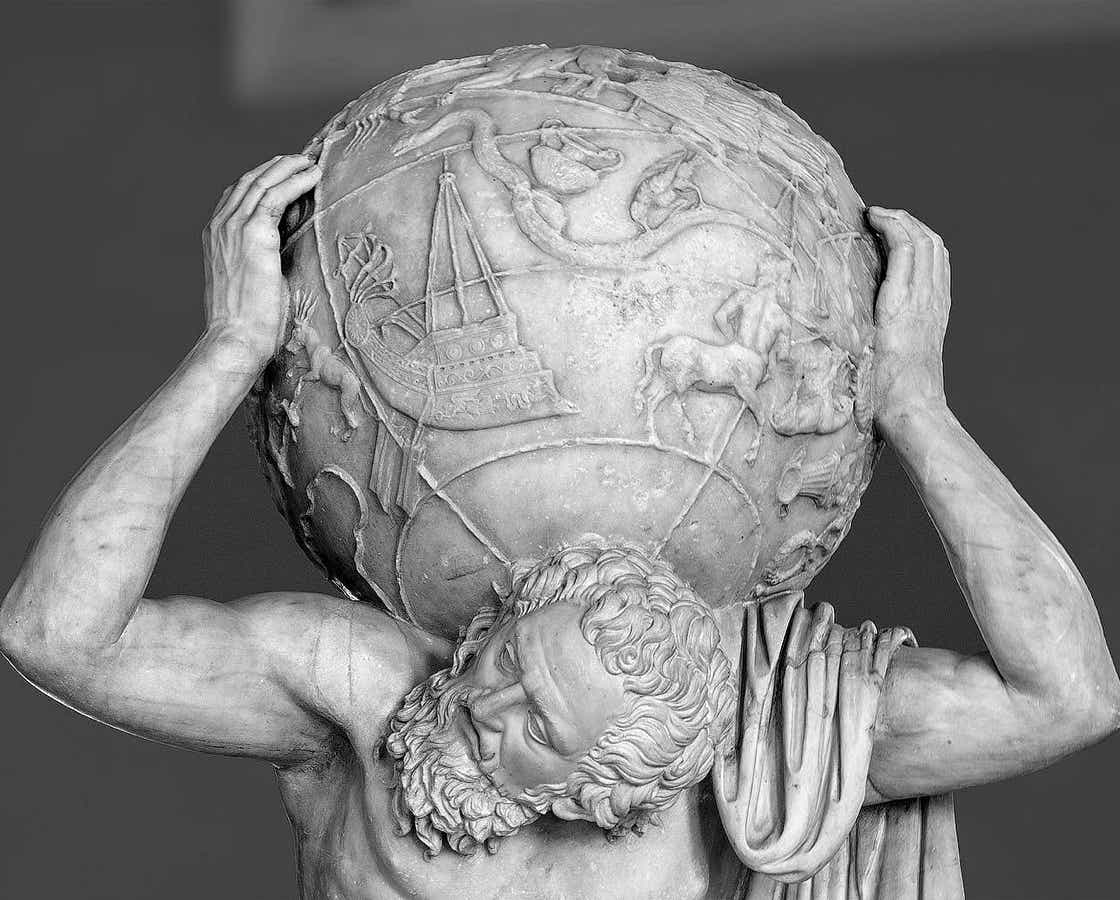The Farnese Atlas celestial globe is opened up into two hemispheres in this engraving of it by Louis-Philippe Boitard (fl. 1733–58). The hemisphere at left is centred on the autumnal equinox, the one at right on the vernal equinox. The celestial equator runs horizontally, crossed at the equinoxes by the band of the zodiac. Grey stippling near the celestial pole at top left is an area of damage, while the grey area in the southern hemisphere is the outline of Atlas’s shoulder, partially obscuring Sagittarius and Capricornus. At the bottom of the left hemisphere is the constellation-free zone that was below the horizon from the Mediterranean. (Author’s collection)
Our earliest view of the ancient Greek constellations comes from a marble statue of Atlas, sinking to his knees as he shoulders a globe of the heavens. Cardinal Alessandro Farnese, grandson of Pope Paul III and an avid collector of antiquities, bought the statue in 1562, exhibiting it among the masterpieces of classical sculpture in his palace in Rome, from which it became known as the Farnese Atlas. It is now displayed in the National Archaeological Museum, Naples.
The sculpture was apparently made in Rome around AD 150 but is thought to be a copy of an older Greek original, pre-dating Ptolemy and perhaps going back to the time of Hipparchus in the second century BC. Although we do not know its exact date, the globe held by the Farnese Atlas is indisputably our earliest look at the star pictures that the ancient Greeks imagined in the sky and which Aratus described in the Phaenomena.
No stars appear on the globe, only constellation figures sculpted in bas-relief along with the major circles of the celestial sphere such as the celestial equator and the ecliptic. Being on the surface of a globe the constellation figures appear reversed by comparison with our view from Earth.
The Farnese globe, about 65 cm in diameter, was not intended for scientific reference, and so lacks the precision of an astronomer’s globe. Rather, it should be regarded as illustrating the familiar story of Atlas being condemned to hold up the heavens and perhaps also the myth reported by the Greek historian Diodorus Siculus (first century BC) that Atlas had ‘discovered the spherical arrangement of the stars’.
Constellations on the Farnese globe
Only three of the 48 constellations listed by Ptolemy in the Almagest were missed off the Farnese globe, namely Equuleus, Sagitta, and Triangulum, all of them small (although Equuleus would not be expected, since the globe is pre-Ptolemaic). Ursa Major, Ursa Minor, and part of Draco are now lost in a damaged area around the north celestial pole, while Piscis Austrinus in the far south is obscured by Atlas’s bulky shoulder.
The illustration above is a drawing of the Farnese globe in stereographic projection by the French-born engraver Louis-Philippe Boitard (fl. 1733–58). This was published in London in 1747 in Polymetis, a book on Roman poetry and art by the English historian Joseph Spence (1699–1768). A similar, but less accurate, drawing of the globe had previously appeared in an edition of Manilius’s Astronomica by Richard Bentley in 1739. Boitard’s drawing is not mentioned by Deborah Jean Warner in her otherwise comprehensive book on celestial cartography, The Sky Explored, although Bentley’s is.
On his drawing, Boitard has added his own representation of Canis Minor in an area covered on the real globe by Atlas’s right hand, and he has also filled in the area around the northerly pan of Libra and the head of Scorpius which is similarly hidden by Atlas’s left hand. Evidently, at the time the globe was made Libra was seen as a pair of scales rather than being the claws of the scorpion, as they were visualized in the time of Aratus and Eratosthenes.
One oddity on the Farnese globe is a frame-like shape north of Cancer the crab which does not correspond to any known constellation (near the top left of Boitard’s drawing). Some have suggested it represents a comet, although it does not look at all like one. Suffice it to say that no satisfactory astronomical explanation for this shape has been given. Perhaps only the (anonymous) sculptor knew.
A detailed study of the globe by the German scholar Georg Thiele was published in 1898 as part of his book Antike Himmelsbilder. This has been translated into English by the historian Hugh Thurston.
© Ian Ridpath. All rights reserved
◄ Back to Star Tales Chapter Two

The celestial globe carried by the Farnese Atlas is about 65 cm across and is engraved with images of the ancient Greek constellations. Here, Argo Navis is seen at left, with Hydra, Crater, and Corvus above centre, and Centaurus on the right. There are no stars on the globe, only major coordinate lines and constellation figures. (Ilia Shurygin)